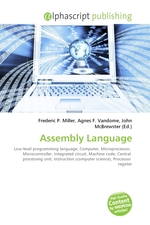Assembly Language
Frederic P. Miller, Agnes F. Vandome, John McBrewster
бумажная книга
Assembly languages are a family of low-level languages for programming computers, microprocessors, microcontrollers, and other (usually) integrated circuits. They implement a symbolic representation of the numeric machine codes and other constants needed to program a particular CPU architecture. This representation is usually defined by the hardware manufacturer, and is based on abbreviations (called mnemonics) that help the programmer remember individual instructions, registers, etc. An assembly language is thus specific to a certain physical or virtual computer architecture (as opposed to most high-level languages, which are usually portable). A utility program called an assembler is used to translate assembly language statements into the target computer's machine code. The assembler performs a more or less isomorphic translation (a one-to-one mapping) from mnemonic statements into machine instructions and data. This is in contrast with high-level languages, in which a single statement generally results in many machine instructions.
Данное издание не является оригинальным. Книга печатается по технологии принт-он-деманд после получения заказа.


